The True Core – Imagery for Organ Movement
When you are in the middle of a workout, have you ever wondered what’s happening to your organs as your body moves? Are they enjoying the twists and turns? Do they feel left out? What if I told you that your internal organs have an important role to play in your movement, influencing your mobility, stability, strength, and coordination? Moving your body can’t help but impact your organs and your organs inevitably influence your movement. Franklin Method imagery for organ movement helps you use that to your advantage so that you can move and feel better.
Why work with the organs?
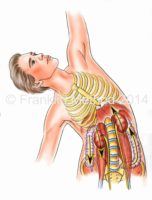 Many people tend to think of their organs as running in the background, quietly performing their functions but completely independent from the musculoskeletal system. In reality, it’s impossible to separate one system from the other – they are inextricably intertwined. Think of your torso as a flexible container filled with water balloons. As the container moves, the water balloons have to slide past one another, compress, stretch, and change shape a bit to accommodate their changing environment. If the balloons aren’t able to respond to the movements of the container, the container won’t be able to move as much.
Many people tend to think of their organs as running in the background, quietly performing their functions but completely independent from the musculoskeletal system. In reality, it’s impossible to separate one system from the other – they are inextricably intertwined. Think of your torso as a flexible container filled with water balloons. As the container moves, the water balloons have to slide past one another, compress, stretch, and change shape a bit to accommodate their changing environment. If the balloons aren’t able to respond to the movements of the container, the container won’t be able to move as much.
We all have aches and pains in our bodies from time to time and we often assume that they are a result of dysfunction in our muscles or joints. While this can certainly be true, sometimes that discomfort originates in the organs. Occasionally this is caused by disease, but more often it’s due to an imbalance in an organ’s tone, its position within the body, or its ability to move. Just as most people have some misalignment between bones or imbalances in muscle tone, it’s common to have some imbalances in the organs.
Organ tone? What is that?
Most people are familiar with the idea of muscle tone because it is visible on the outside of the body. When I ask a new Pilates client what their goals are, toning their muscles is often high on the list. Organs also have tone – the organ’s ability to maintain its own inner spring or elasticity. Organs maintain their tone through constant intrinsic movement, like the winding and unwinding of a coiled spring or the squeezing of a sponge. However, this process can be impeded by poor posture, shallow breathing, lack of movement, or stress. Have you ever held a baby as it falls asleep? Even though its objective weight hasn’t changed, it feels much heavier as its muscle tone drops with oncoming sleep. If an organ loses its tone it will feel heavier and sag from its proper place in the body, reducing its ability to function well and putting stress on the tissues around it. You can help your organs maintain their intrinsic tone by moving your body well, including deep breathing, good posture, and mindful exercise.
The organs are your true “core”
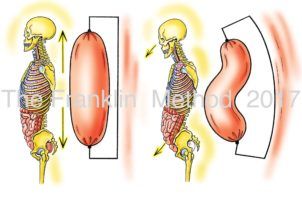 The “core” is a common buzz word in fitness these days and it usually refers to a combination of muscles that work together to support your torso: the pelvic floor, the breathing diaphragm, the abdominal wall and deep spinal muscles like the multifidus. While having these muscles in good working condition is important for healthy movement, they are not the whole story when working with the so-called core. In fact, these muscles create a container that houses many of the body’s internal organs. I would argue that these organs can be thought of as your true core, and incorporating them in your movement practice is fundamental to optimal physical health. Your organs can be excellent training partners for your core muscles. They provide resistance and spring from inside your body that your core muscles work with to stay strong and healthy. If your organs lose their tone or aren’t able to slide past each other smoothly, they can make it harder for your core muscles to do their job effectively.
The “core” is a common buzz word in fitness these days and it usually refers to a combination of muscles that work together to support your torso: the pelvic floor, the breathing diaphragm, the abdominal wall and deep spinal muscles like the multifidus. While having these muscles in good working condition is important for healthy movement, they are not the whole story when working with the so-called core. In fact, these muscles create a container that houses many of the body’s internal organs. I would argue that these organs can be thought of as your true core, and incorporating them in your movement practice is fundamental to optimal physical health. Your organs can be excellent training partners for your core muscles. They provide resistance and spring from inside your body that your core muscles work with to stay strong and healthy. If your organs lose their tone or aren’t able to slide past each other smoothly, they can make it harder for your core muscles to do their job effectively.
What is the Franklin Method and how does it address the organs?
The Franklin Method is a practical, experiential system designed by Eric Franklin that uses cutting edge exercise, motivation, and dynamic imagery to create lasting positive change in your body and mind. Harnessing the brain’s innate adaptability, it pairs Dynamic Neurocognitive Imagery tools with embodied anatomy to improve your experience in your body. I’ve been teaching the Franklin Method since 2011 and it has transformed the way I practice and teach Pilates, as well as how I move and feel in my daily life. My favourite thing about this approach is how it gives people from all walks of life the opportunity, skills, and agency to improve their experience in their body – at any time, in any place.
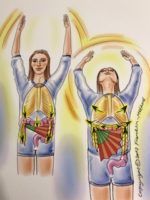 I recently completed the Franklin Method Level 3 Teacher Training, which focuses on using imagery to optimize your organs’ function, tone, and movement. I learned that the organs are an integral part of healthy, efficient, and pleasurable movement. Franklin Method imagery is uniquely suited to working with the organs as it has been shown to influence the autonomic nervous system, which the part of your nervous system that controls the organs. This system allows your organs to function automatically, outside your voluntary control. The advantage of this is that you don’t have to consciously breathe, or beat your heart, or digest your food. The disadvantage is that you can’t choose to lift your bladder or give your liver a squeeze if you want to. What you can do, is use imagery as you move to re-balance your organs and encourage a sense of well-being, better movement skills, alignment, and mood.
I recently completed the Franklin Method Level 3 Teacher Training, which focuses on using imagery to optimize your organs’ function, tone, and movement. I learned that the organs are an integral part of healthy, efficient, and pleasurable movement. Franklin Method imagery is uniquely suited to working with the organs as it has been shown to influence the autonomic nervous system, which the part of your nervous system that controls the organs. This system allows your organs to function automatically, outside your voluntary control. The advantage of this is that you don’t have to consciously breathe, or beat your heart, or digest your food. The disadvantage is that you can’t choose to lift your bladder or give your liver a squeeze if you want to. What you can do, is use imagery as you move to re-balance your organs and encourage a sense of well-being, better movement skills, alignment, and mood.
Give it a try – Pelvic Curls with Bladder Rolling:
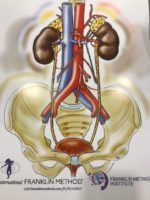 Most people have a pretty good idea of where their bladder is in their body, since you can feel it pretty distinctly when it is full! If you’re not sure, take a look at the image on the right of the kidneys and the bladder. It is centred low in the pelvis, right behind the pubic bones. Try performing a few simple pelvic curls and see if using bladder imagery gives you a different experience than you’re used to.
Most people have a pretty good idea of where their bladder is in their body, since you can feel it pretty distinctly when it is full! If you’re not sure, take a look at the image on the right of the kidneys and the bladder. It is centred low in the pelvis, right behind the pubic bones. Try performing a few simple pelvic curls and see if using bladder imagery gives you a different experience than you’re used to.
Lie down on your back with your legs bent and feet flat on the ground.
Sense into your body and see if you can feel, or see in your mind’s eye, where your bladder is – just behind your pubic bones.
Imagine rolling your bladder gently towards your head and allow your pelvis to follow its movement.
Imagine rolling the bladder back towards your feet and allow your pelvis to return to a resting position.
Repeat this process several times and feel free to get creative with the imagery. Maybe your bladder is a ball rolling along the sacrum bone. Perhaps it is a little row boat being rocked back and forth by the waves. What comes to mind for you?
Then perform a few pelvic curls without the bladder in mind, just thinking of the abdominals sinking and curling your tailbone around the corner. How does this feel compared to doing the action with the bladder imagery? I often find the organ image produces a more effortless, satisfying experience.
Let us know in the comments how the experience was for you.
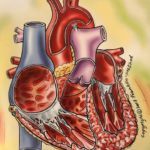 Save The Date: Move From the Heart – February 17, 2020
Save The Date: Move From the Heart – February 17, 2020
Show your heart a little love! Allison Birt will be teaming up with esteemed medical herbalist Bev Maya for a special heart workshop on February 17. Combining the dynamic imagery of the Franklin Method with the healing power of plants, this workshop will give you the tools to optimize your heart health. Registration opens January 2020 – stay tuned for more details!
About Allison Birt
 After a series of injuries prompted her to re-consider a career in dance, Allison transformed her passion for movement as art into a passion for movement as medicine. In 2001 she began learning to teach Pilates from Dianne Miller, teaching at the Vancouver Pilates Centre until 2016. A perennial student, Allison has learned from and studied the repertoire of multiple first-generation Pilates teachers including Ron Fletcher, Kathleen Stanford Grant, and Mary Bowen. Allison is also a Level 3 Franklin Method Educator, adept at applying mental imagery techniques to embodied anatomy to create lasting positive change in the mind and body. She loves to collaborate with students to help them discover movement resolutions that will maximize their physical potential so that they can move through their lives with as much ease and joy as possible.
After a series of injuries prompted her to re-consider a career in dance, Allison transformed her passion for movement as art into a passion for movement as medicine. In 2001 she began learning to teach Pilates from Dianne Miller, teaching at the Vancouver Pilates Centre until 2016. A perennial student, Allison has learned from and studied the repertoire of multiple first-generation Pilates teachers including Ron Fletcher, Kathleen Stanford Grant, and Mary Bowen. Allison is also a Level 3 Franklin Method Educator, adept at applying mental imagery techniques to embodied anatomy to create lasting positive change in the mind and body. She loves to collaborate with students to help them discover movement resolutions that will maximize their physical potential so that they can move through their lives with as much ease and joy as possible.
